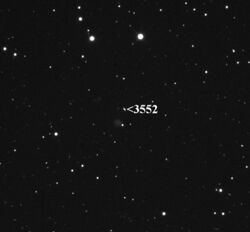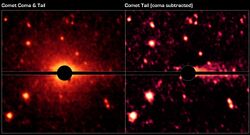Astronomy:3552 Don Quixote
 Don Quixote (apmag 15) near perihelion taken in Pingelly, Australia, 2009 | |
| Discovery [1] | |
|---|---|
| Discovered by | P. Wild |
| Discovery site | Zimmerwald Obs. |
| Discovery date | 26 September 1983 |
| Designations | |
| (3552) Don Quixote | |
| Named after | Don Quixote fictional character[2] |
| 1983 SA | |
| Minor planet category | NEO · Amor [1] Mars-crosser Jupiter-crosser Centaur [3] |
| Orbital characteristics [1] | |
| Epoch 4 September 2017 (JD 2458000.5) | |
| Uncertainty parameter 0 | |
| Observation arc | 33.71 yr (12,312 days) |
| |{{{apsis}}}|helion}} | 7.2783 AU |
| |{{{apsis}}}|helion}} | 1.2399 AU |
| 4.2591 AU | |
| Eccentricity | 0.7089 |
| Orbital period | 8.79 yr (3,211 days) |
| Mean anomaly | 332.47° |
| Mean motion | 0° 6m 43.56s / day |
| Inclination | 31.092° |
| Longitude of ascending node | 350.03° |
| 316.42° | |
| Earth MOID | 0.3338 AU |
| Jupiter MOID | 0.4397 AU |
| TJupiter | 2.3150 |
| Physical characteristics | |
| Dimensions | 18.4±0.4 km[4] |
| Rotation period | 7.7 h (0.32 d)[3][5] |
| Geometric albedo | 0.03[1][4] |
| D (Tholen) · D (SMASS) | |
| Apparent magnitude | 11.67 (1957) to 22.32[lower-alpha 1] |
| Absolute magnitude (H) | 12.9 |
3552 Don Quixote, provisionally designated 1983 SA, is an exceptionally eccentric asteroid, classified as a near-Earth object of the Amor group, Mars-crosser and Jupiter-crosser, as well as a weakly active comet.
Discovery and naming
The asteroid was discovered on 26 September 1983, by Swiss astronomer Paul Wild at Zimmerwald Observatory near Bern, Switzerland.[6] It was named after the comic knight who is the eponymous hero of Cervantes' Spain novel Don Quixote (1605).[2] The approved naming citation was published by the Minor Planet Center on 2 December 1990 (M.P.C. 17466).[7]
Orbit and characteristics
Don Quixote is characterized as a dark D-type asteroid in the Tholen and SMASS taxonomy.[1]
It has a highly inclined comet-like orbit of 31 degrees that leads to frequent perturbations by Jupiter.[8] Don Quixote measures 18.4 kilometres in diameter and has a rotation period of 7.7 hours.[1][4]
Due to its comet-like orbit and albedo, Don Quixote has been suspected to be an extinct comet.[9] However, infrared observations with the Spitzer Space Telescope at 4.5 μm revealed a faint coma and tail around the object.[4] The cometary activity is inferred by carbon dioxide (CO
2) molecular band emission. In March 2018 a tail was observed at visible wavelengths for the first time.[10] The observation of cometary features during two apparitions suggests that cometary activity is recurrent and Don Quixote is most likely a weakly active comet.[11]
Notes
- ↑ Magnitudes generated with JPL Horizons for the year 1950 through 2100
References
- ↑ 1.0 1.1 1.2 1.3 1.4 1.5 "JPL Small-Body Database Browser: 3552 Don Quixote (1983 SA)". Jet Propulsion Laboratory. https://ssd.jpl.nasa.gov/sbdb.cgi?sstr=2003552.
- ↑ 2.0 2.1 Schmadel, Lutz D. (2007). "(3552) Don Quixote". Dictionary of Minor Planet Names – (3552) Don Quixote. Springer Berlin Heidelberg. p. 298. doi:10.1007/978-3-540-29925-7_3551. ISBN 978-3-540-00238-3.
- ↑ 3.0 3.1 "LCDB Data for (3552) Don Quixote". Asteroid Lightcurve Database (LCDB). http://www.minorplanet.info/PHP/generateOneAsteroidInfo.php?AstInfo=3552%7CDon%20Quixote.
- ↑ 4.0 4.1 4.2 4.3 Mommert, Michael; Hora, Joseph L.; Harris, Alan W.; Reach, William T.; Emery, Joshua P.; Thomas, Cristina A. et al. (January 2014). "The Discovery of Cometary Activity in Near-Earth Asteroid (3552) Don Quixote". The Astrophysical Journal 781 (1): 10. doi:10.1088/0004-637X/781/1/25. Bibcode: 2014ApJ...781...25M. http://adsabs.harvard.edu/cgi-bin/bib_query?bibcode=2014ApJ...781...25M. Retrieved 16 June 2017.
- ↑ "European Asteroid Research Node:(3552) Don Quixote". http://earn.dlr.de/nea/003552.htm.
- ↑ "3552 Don Quixote (1983 SA)". Minor Planet Center. https://www.minorplanetcenter.net/db_search/show_object?object_id=3552.
- ↑ "MPC/MPO/MPS Archive". Minor Planet Center. https://www.minorplanetcenter.net/iau/ECS/MPCArchive/MPCArchive_TBL.html.
- ↑ "JPL Close-Approach Data: 3552 Don Quixote (1983 SA)". https://ssd.jpl.nasa.gov/sbdb.cgi?sstr=3552;cad=1#cad.
- ↑ Lupishko, D. F.; di Martino, M.; Lupishko, T. A. (September 2000). "What the physical properties of near-Earth asteroids tell us about sources of their origin?". Kinematika I Fizika Nebesnykh Tel Supplimen 3 (3): 213–216. Bibcode: 2000KFNTS...3..213L. http://adsabs.harvard.edu/cgi-bin/bib_query?bibcode=2000KFNTS...3..213L. Retrieved 16 June 2017.
- ↑ Mommert, Michael (March 2018). "CBET 4502: 20180329 : (3552) DON QUIXOTE". Central Bureau of Electronic Telegrams (Harvard). http://www.cbat.eps.harvard.edu/iau/cbet/004500/CBET004502.txt.
- ↑ Mommert, Michael; Hora, Joseph L.; Trilling, David E.; Biver, Nicolas; Wierzchos, Kacper; Harrington Pinto, Olga; Agarwal, Jessica; Kim, Yoonyoung et al. (1 June 2020). "Recurrent Cometary Activity in Near-Earth Object (3552) Don Quixote". The Planetary Science Journal 1 (1): 12. doi:10.3847/PSJ/ab8ae5.
External links
- Asteroid Lightcurve Database (LCDB), query form (info )
- Dictionary of Minor Planet Names, Google books
- Asteroids and comets rotation curves, CdR – Observatoire de Genève, Raoul Behrend
- Discovery Circumstances: Numbered Minor Planets (1)-(5000) – Minor Planet Center
- 3552 Don Quixote at NeoDyS-2, Near Earth Objects—Dynamic Site
- Ephemeris · Obs prediction · Orbital info · MOID · Proper elements · Obs info · Close · Physical info · NEOCC
- 3552 Don Quixote at the JPL Small-Body Database
 |


